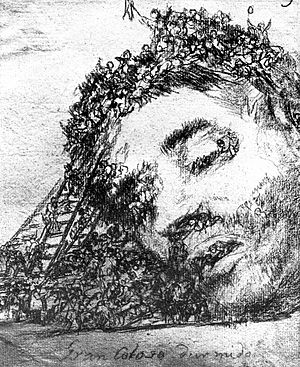The Colossus (painting) facts for kids
Quick facts for kids The Colossus |
|
|---|---|
| Spanish: El Coloso | |
| Artist | attributed to Francisco de Goya |
| Year | after 1808 |
| Medium | Oil on canvas |
| Dimensions | 116 cm × 105 cm (46 in × 41 in) |
| Location | Museo del Prado, Madrid |
The Colossus is a famous painting that shows a huge giant. It is also called The Giant. In Spanish, it is known as El Coloso, El Gigante (The Giant), El Pánico (The Panic), or La Tormenta (The Storm). Many people believe the famous artist Francisco de Goya painted it.
The painting shows a giant walking to the left side of the picture. Mountains hide his legs, and clouds are around his body. The giant looks strong and ready for action, holding one of his fists up. Below the giant, there is a dark valley. Many people and animals like cows are running away in fear.
Goya's son, Javier Goya, owned the painting in 1812. Later, it belonged to Pedro Fernández Durán. He gave his art collection to the Museo del Prado in Madrid. The painting has been kept there since 1931.
The Story of the Painting
The Colossus became part of the Museo del Prado's collection in 1931. It was given to the museum by the family of Pedro Fernández Durán. The first time the painting was officially said to be by Goya was in 1946. This was when a list of Goya's wife's belongings was published. The list from 1812 described a painting of "a giant" that was the same size as The Colossus.
The painting was later passed down through different family members. It was described in a family document in 1877. At that time, it was called "A picture that predicts the sad events of the War of Independence." It was also noted as an "original Goya" painting.
People have recently wondered if Goya truly painted The Colossus. This is because a similar drawing by Goya, called The Giant, looks very much like the painting. This drawing is an etching, which is a type of printmaking. Experts have studied how the giant in the etching changes from being strong to looking sad. This change might show the feelings of many Spanish people during the Peninsular War.
If the painting was made between 1808 (when the war started) and 1812 (when it was listed as Goya's son's property), then the etching was likely made after the war. This is because of the way Goya made his famous series of prints called The Disasters of War.
See also
 In Spanish: El coloso para niños
In Spanish: El coloso para niños
- List of works by Francisco Goya
- 100 Great Paintings, a BBC TV series from 1980


